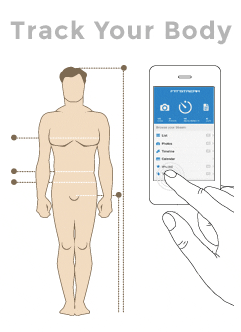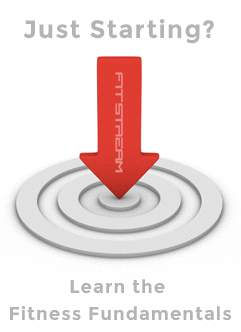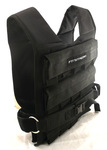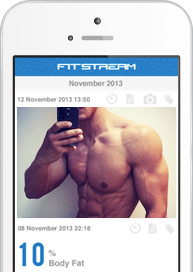So, you’re sold on the benefits of tracking your health and fitness we covered in our last article and now want some guidance on how to actually start tracking and what information to record... let’s get started.
We've captured an overview of the tracking process in the diagram below to show you how the data is recorded and used.
![]()
The first place to start is to decide what method you’re going to use to record your progress - paper-based or digital? There’s an element of personal preference here, but there are advantages and disadvantages of both, which we look at below.
 Paper-based fitness tracking
Paper-based fitness tracking
Some people prefer the old school approach to record keeping and break out the notebook and pen, scribbling down numbers between sets.
If this sounds like you and you need a template for your workout log then we've created a free to download PDF to print out and record your strength workouts or cardio workouts.
The upside to paper-based journaling is that it’s easy to do, with no real learning curve; all you need is paper, a pen and the ability to write!
Other advantages of paper logging include;
- No dependency on battery life
- No possibility of electrical or software failure
- Some people enjoy the nostalgia of scribbling away in a pad which can be lost in digital record keeping
- Avoids getting disatracted by your phone or other technology services when you're trying to train
Digital fitness tracking
We believe that technology is revolutionising personal health and fitness, and giving us incredible insight that wouldn't otherwise be possible. There are real advantages to tracking yourself digitally that might tempt you away from paper. So, here’s our take on tracking things digitally...
Here are just a few of the benefits to going digital -
| Benefits of digital fitness tracking | Notes |
|---|---|
| Data security and access |
Your data is safe and securely stored, and (in many cases) backed-up and synchronised across devices (so that you’re able to record on your phone and report on your laptop / tablet). Compare to paper journals which can be lost, destroyed or accessed by others this is a significant advantage. |
| Time-saving and convenience |
Data recording can be automatic with technology like digital weighing scales syncing up with your mobile and run mapping software tracing routes, distances and speed using your phone GPS and accelerometer features. Automatic logs saves you time so that you can focus on making improvements rather than recording the data. |
| Progress and trend spotting |
Smart algorithms can spot trends and give insight into performance and progress. For example, giviing you insight into why your bodyweight is increasing. Is body fat reducing and muscle mass increasing? Smart apps can combine data sets and give you real value into changes in your health and body. |
| Reporting and analysis |
You have the ability to see progress reports and really delve into the data. Paper logs aren't very well suited to numerical information, whereas an digital service can automatically map your data and allow you to analyse it in varies ways on your phone or computer. Digital services can easily track information such as your Personal Bests or other records. |
| Resource libraries |
Some app have built in libraries and resources of information available to you during workouts for reference and inspiration (exercises, workouts, past logs). This is always handy when you need that extra help or motivation. |
| Ability to easily find information |
With digital logs you have the ability to easily search your journals to find specific information that would otherwise be difficult with paper records. Some apps now offer smart tagging features for easy filtering. |
| Social sharing |
Many services now integrate directly with your social networks so that you're able to share your accomplishments with your network of friends for support. A proven strategy for helping to sustain motivation. |
Digital record keeping is a smart choice and can help to manage your training, keep you motivated and gain insight into how you respond, in order to ensure you reach your goals quicker.
Fitness Tracking Technologies
So, what services should you use to record this data? There’s an ever growing range of applications available to you and they’re evolving all the time.
If you like more control over how you record your data, many prefer to use their own spreadsheet solution as this provides a flexible framework that you can configure on your own terms, putting you in control, but there are also many purpose-built tracking apps that are valuable too, or offer features that spreadsheets can't.
We’ve outlined a selection of current popular apps below, that span a diverse range of health and fitness areas -
| Health and fitness apps and services | Notes |
|---|---|
| Fitocracy | Workout tracking with an emphasis on social sharing, point scoring and gamification. |
| MyFitnessPal | Primarily a diet logging and calorie counting tool (with over two million food items in their database!) |
| RunKeeper | Track the duration, length, distance and calories burned of your runs or other outdoor fitness activities |
| Fitstream |
We've designed our very own fitness journaling service which allows you to track body measurements, notes and progress photos. We also have a public community for logs that you want to share with a wider group for advice and inspiration. |
| StrongLifts “5x5” | A popular strength training program and tracking application |
| Moves | A smart pedometer for tracking daily steps using your phone |
| Everest | A goal setting and tracking application to help break steps down |
| Up by Jawbone | Users wear a wristband that tracks movement and sleep with an accompanying app to display the data |
| Sleep Cycle | This iOS app analyses a users' sleep patterns and wakes them when they're in the lightest phase of sleep, with analytics to display how well you’re sleeping. |
| Cardiio | Is a heart rate monitoring tool using nothing other than your phone to measure the rate, and includes estimates for life expectancy |
| GlucoseBuddy | Is a great app for diabetics in which users can monitor blood glucose levels, record when they take their medication, and track food intake and activity. |
As you can see from this list, there’s a diverse range of services emerging and this is only a handful of what can be found. The Apple App Store alone is populated with tens of thousands of Health and Fitness applications!
Now that you know how you're going to track your information we’d like to look at what information you'll be recording in your journal.
Choosing what information to track
What are you measuring? Keeping track of the wrong data, or reading it wrong is worse than not keeping track at all.
Seth Godin
![]()
There’s a tonne of information that you could be tracking, and technology is making it easier than ever before to make this as little effort and as intuitive as possible to do.
What you do choose to track will at the very least require an investment of time (although the rise in wearable technology is in some cases making data collection automatic) so it’s important you’re tracking the right data that’s in line with your goals. Check out our fitness planning article if you haven’t yet decided on your fitness goals.
We've compiled this list of health and fitness metrics that people are commonly tracking to help inspire your fitness journals. Note that some of these logs would require specialist equipment in order to measure.
- Photos & Progress Pictures
- Body shots (full body and individual body parts)
- Food, meals and drinks
- Inspirational and motivational pictures
- Body Measurement Tracking
- Body weight, body fat %, BMI
- Heart rate / resting heart reate, heart rate variability
- Bicep, calf, chest, forearm, hips, neck, shoulders, thigh, waist
- Dress size
- Height
- Body temperature
- Health Metric Tracking
- pH
- Blood glucose / blood sugar levels
- Blood pressure
- Respiration / breathing rate
- Oxygen levels
- Diet, Nutrition & Food Journal
- Calories
- Total fat, saturated fat
- Protein
- Carbohydrates
- Sugars
- Fiber
- Sodium
- Cholesterol
- % of daily allowance
- Hyrdation levels / water intake
- Activity and Movement Tracking
- Workouts / exercise
- Personal bests
- Reps, weight, rest time, rounds, rep scheme
- Steps
- Distance
- Calorie burn
- Dates, times and duration
- Posture
- Psychological / Brain Activity Tracking
- General mood
- Brain activity
- Sleep Patterns
- Duration
- Quality of sleep
To help choose from this list, ask yourself "what information do I want to know now about how I was a year ago?"
The most popular metrics that are tracked include; bodyweight, progress pictures, body fat %, exercise personal bests (e.g. 180kg Bench Press).
Hopefully this article has inspired you to start tracking your health and fitness today. The benefits are astounding and we've witnessed some incredible transformations over the years just by committing a few minutes a week to keeping some basic records. It helps you stay motivated, keeps you accountable and you start to understand your body and how it's changing over time.
Why not get started today?
Tags: Fitness tracking, fitness logging, fitness records, fitness journal, fitness diary, quantified self, lifelogging, health tracking.











